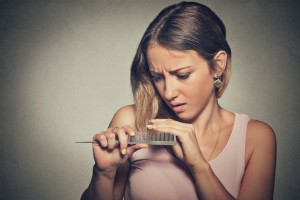Trichotillomania is repetitive pulling out of one’s hair resulting in noticeable hair loss. This hair-pulling and associated hair loss cause considerable distress or impairment in daily functioning. While many people (up to 15%) may pull hair without impact, pulling hair in excess can result in serious medical problems. Hair-pulling can also lead to feelings of isolation, shame and confusion. As a result many people try to hide their difficulties and are reluctant to seek help.
Places people commonly pull hair from include:
- Scalp
- Eyebrows
- Eyelashes
- Beards
- Pubic area
Trichotillomania usually first starts around 11-13 years of age, but there are cases of hair-pulling for very young children and babies. Some people experience a feeling of tension, itchiness, pain or tingling prior to pulling. These initial feelings lead to a strong urge to engage in the hair-pulling. They then experience relief from this sensation and pleasure when pulling the hair (this is called ‘focused pulling’).
At other times individuals may engage in automatic hair-pulling without awareness of what they are doing. This type of hair-pulling is more likely to occur during sedentary activities such as watching television. Many individuals also have post-pulling rituals such as rubbing the hair between their fingers, examining the hair, and eating, chewing, or swallowing hair.
Treatment for Trichotillomania
Cognitive-behaviour therapy (CBT) and Habit Reversal Therapy (HRT)
A comprehensive behavioural intervention called Habit Reversal Therapy (HRT) has been shown to reduce hair pulling. HRT also improves the person’s ability to cope with unpleasant thoughts, feelings and sensations, and improve their overall quality of life.
The main components of HRT treatment for Trichotillomania are:
Awareness Training
This involves teaching the individual to describe in detail their pulling behaviour and become more aware of the urges and warning signals associated with pulling. The individual then practices noticing the warning signs, and any real or simulated hair-pulling.
Competing Response Training
The individual is helped to choose a behaviour that is physically incompatible with the hair-pulling. For example, if hair-pulling occurs while reading, a competing response would be to always hold the book with both hands. The individual practices this behaviour when the urge or warning signals are noticed or when the individual notices they have started pulling. The purpose of this is to break the link between the urge to pull and the hair-pulling.
Substitute behaviours that meet the body’s sensory needs while stopping the problem behaviour may also be identified and utilised. For example, for individuals who roll the hair between their fingers, rolling a piece of wool may be suggested as an alternative.
Stimulus Control
Factors in the environment that trigger the hair-pulling are identified. A problem-solving approach is then taken to identify strategies to manage or avoid these environmental factors. For example, if hair-pulling occurs while looking in the mirror, mirrors may be removed or covered up for a period of time.
Managing Difficult Thoughts and Feelings
Individuals with Trichotillomania often experience a number of other conditions such as anxiety, low self-esteem, shame, social isolation/rejection and depression. Cognitive Behavioural Therapy (CBT) can be used to teach strategies to cope with and manage the symptoms of these co-occurring conditions. CBT helps the person to manage unpleasant thoughts, feelings and urges that are likely to lead to hair-pulling. This is particularly important as internal states such as stress and anxiety are likely to influence the frequency and intensity of hair-pulling.
Acceptance and Commitment Therapy (ACT) can also be used to assist the individual to identify their values and use these values as motivation to make space for and respond differently to unpleasant thoughts, feelings and sensations.
Improving Quality of Life
Many individuals with Trichotillomania withdraw from social relationships, vocational interests and other life activities as a result of their hair-pulling behaviour and the feelings of shame associated with it. One goal of therapy is to assist with re-engaging in these activities and addressing difficult thoughts and feelings that may get in the way of this.
Medication
Recent research into the treatment of Trichotillomania using N-acetylcysteine (NAC) supplements has shown that the supplement can be effective in reducing the hair-pulling. N-acetylcysteine is a natural amino acid that is used to treat chest infections and liver disease.
While the relationship between N-acetylcysteine and TTM is not clear yet, researchers have suggested that NAC helps reduce the glutamate concentrations in the brain that lead to repetitive behaviours. NAC can be found at most pharmacies and health food stores.
If you would like to find out more about our treatment for Trichotillomania, or to book an appointment with one of our clinical psychologists who provides treatment for this condition, please email or call the clinic on 02 9438 2511.

